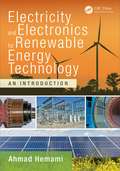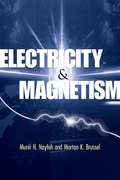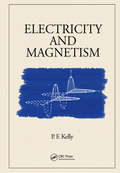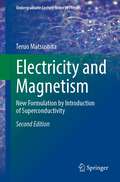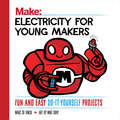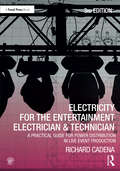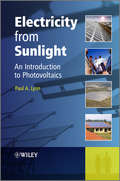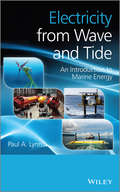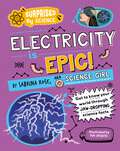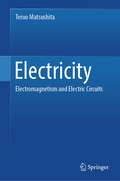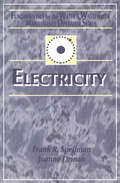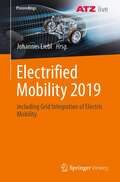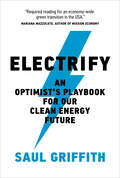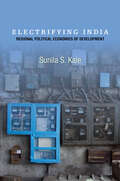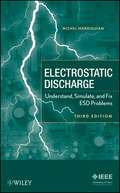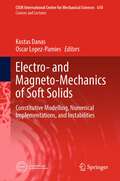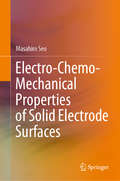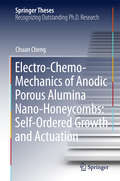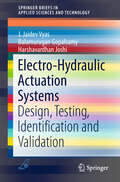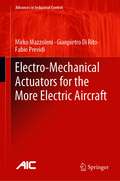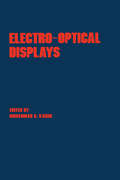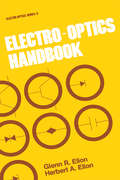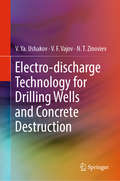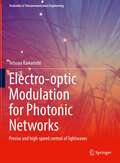- Table View
- List View
Electricity and Electronics for Renewable Energy Technology: An Introduction (Power Electronics and Applications Series)
by Ahmad HemamiElectricity and Electronics for Renewable Energy Technology: An Introduction provides a foundational understanding of electricity and the methods and devices specific to electricity from renewable sources. The book begins with a brief explanation of the necessary mathematics and then: Addresses the basics of electricity and relationships, motors and generators, transformers, and networks and distribution Tackles the key concepts associated with electronics, diodes and transistors, switching devices, and power converters Covers digital electronics from number systems and logic circuits to encoders and decoders Explores advanced subjects such as reactive power and the operation of a transistor A lab manual and PowerPoint presentation are available with qualifying course adoption. Featuring extensive review questions and practice problems at the end of each chapter, Electricity and Electronics for Renewable Energy Technology: An Introduction instills an essential knowledge of electricity and electronics required for work with renewable energy.
Electricity and Magnetism
by Dr Munir H. Nayfeh Dr Morton K. BrusselThis outstanding text for a two-semester course is geared toward physics undergraduates who have completed a basic first-year physics course. The coherent treatment offers several notable features, including 300 detailed examples at various levels of difficulty, a self-contained chapter on vector algebra, and a single chapter devoted to radiation that cites interrelationships between various analysis methods. Starting with chapters on vector analysis and electrostatics, the text covers electrostatic boundary value problems, formal and microscopic theories of dielectric electrostatics and of magnetism and matter, electrostatic energy, steady currents, and induction. Additional topics include magnetic energy, circuits with nonsteady currents, Maxwell's equations, radiation, electromagnetic boundary value problems, and the special theory of relativity. Exercises appear at the end of each chapter and answers to odd-numbered problems are included in one of several helpful appendixes.
Electricity and Magnetism
by P.F. KellyThe final volume in a three-part series, Electricity and Magnetism provides a detailed exposition of classical electric and magnetic fields and analyses of linear electric circuits. The book applies the principles of classical mechanics to systematically reveal the laws governing observed electric and magnetic phenomena. The text culminates in Maxw
Electricity and Magnetism: New Formulation by Introduction of Superconductivity (Undergraduate Lecture Notes in Physics)
by Teruo MatsushitaThis book is a very comprehensive textbook covering in great depth all the electricity and magnetism. The 2nd edition includes new and revised figures and exercises in many of the chapters, and the number of problems and exercises for the student is increased.In the 1st edition, emphasis much was made of superconductivity, and this methodology will be continued in the new edition by strengthening of the E-B analogy. Many of the new exercises and problems are associated with the E-B analogy, which enables those teaching from the book to select suitable teaching methods depending on the student’s ability and courses taken, whether physics, astrophysics, or engineering.Changes in the chapters include a detailed discussion of the equivector-potential surface and its correspondence between electricity and magnetism. The shortcomings of using the magnetic scalar potential are also explained. The zero resistivity in a magnetic material showing perfect diamagnetism can be easily proved.This textbook is an ideal text for students, who are competent in calculus and are taking physics, astrophysics, or engineering at degree level. It is also useful as a reference book for the professional scientist.
Electricity and Magnetism: New Formulation by Introduction of Superconductivity (Undergraduate Lecture Notes in Physics)
by Teruo MatsushitaThis comprehensive textbook covers electricity and magnetism in great depth, with the 3rd edition offering updated descriptions of electromagnetic phenomena to help students achieve a more thorough understanding of the subject. In the 1st edition, superconductivity was emphasized, a focus that continued in the 2nd edition, which strengthened the E-B analogy by comparing equipotential surfaces in electricity to equivector potential surfaces in magnetism. The 3rd edition introduces the concept of mean magnetic flux, which aids in determining inductance from magnetic energy. It also demonstrates how vector potential can be directly used to calculate electromotive force. A unique phenomenon is presented when applying current to a superconducting transmission line, where the induced electric field's vector potential is perpendicular to the current. This deviation from common equations can still be explained through Maxwell&’s theory, leading to the correct solution. For a more in-depth grasp of electricity and magnetism, students are encouraged to use Exercises in Electricity and Magnetism by the same author, which offers 400 practice problems. This textbook is ideal for advanced students of physics, astrophysics, or engineering, as well as a valuable reference for professional scientists.
Electricity for Young Makers: Fun and Easy Do-It-Yourself Projects
by Marc De VinckLearning to be a maker has never been more fun. Lavishly illustrated with cartoons and drawings, this book guides the reader through six hands-on projects using electricity. Discover the electrical potential lurking in a stack of pennies - enough to light up an LED or power a calculator! Launch a flying LED copter into the air. Make a speaker that plays music from an index card. Build working motors from a battery, a magnet, and some copper wire. Have fun while learning about and exploring the world of electricity. The projects in this book illuminate such concepts as electric circuits, electromagnetism, electroluminescence, the Lorentz force and more. You'll be amazed by the results you get with a handful of simple materials.
Electricity for the Entertainment Electrician & Technician: A Practical Guide for Power Distribution in Live Event Production
by Richard CadenaNow in its third edition, Electricity for the Entertainment Electrician & Technician is a comprehensive, practical study guide for aspiring and working professionals in live event production.The book covers every aspect of power distribution from the fundamentals, like basic circuits, to 3-phase power, power calculations, grounding and bonding, electrical safety, portable power generators, and battery power. With ample photographs and illustrations, practice problems and solutions, and real-world examples from experience and first-hand accounts, it provides readers with the knowledge to safely design, set up, and monitor power distribution systems. The third edition expands on grounding and bonding, portable power generators, balanced and unbalanced 3-phase power calculations, battery power, and more. The last chapter walks readers through the process of prepping for a show, setting up a portable power distribution system, and monitoring every aspect of the system, including voltage, current, and heat using an infrared camera, explaining in detail best practices and the logic behind them.Covering topics that are listed in the content outline for the ETCP Entertainment Electrician Certification exam as well as the ETCP Portable Power Distribution Technician Certification exam, this reference supports practicing technicians and provides new technicians the assistance they need for a successful career in the entertainment industry.Additional resources, including conversion tables, voltage spreadsheets, articles from Lighting & Sound International, Lighting & Sound America, and Protocol, and animations and illustrations depicting electricity and electric power distribution developed for the author’s workshops, can be found on the companion website www.electrics.tech.
Electricity from Sunlight
by Paul A. LynnA lively and authoritative account of today's photovoltaic (PV) technology and its practical applicationsThis book covers areas including:a brief history of PV, and the current international scene; the scientific principles of solar cells including silicon and new thin-film varieties; PV modules and arrays; grid-connected PV, from home systems up to large power plants; the wide diversity of stand-alone PV systems, and; the economic and environmental aspects of solar electricity. Key equations and numerical examples are fully discussed, providing essential theoretical background. The text is supported by copious illustrations and more than eighty inspiring full colour photographs from around the world to demonstrate PV's huge range of practical applications.This book is aimed at a wide readership including professionals working in related areas, and students taking introductory courses in PV and renewable energy. Its style and level will also appeal to energy planners and decision makers, members of environmental organisations, and the increasing number of people interested in generating their own electricity from sunlight.
Electricity from Wave and Tide
by Paul A. LynnA concise yet technically authoritative overview of modern marine energy devices with the goal of sustainable electricity generationWith 165 full-colour illustrations and photographs of devices at an advanced stage, the book provides inspiring case studies of today's most promising marine energy devices and developments, including full-scale grid-connected prototypes tested in sea conditions. It also covers the European Marine Energy Centre (EMEC) in Orkney, Scotland, where many of the devices are assessed.Topics discussed:global resources - drawing energy from the World's waves and tideshistory of wave and tidal stream systemstheoretical background to modern developmentsconversion of marine energy into grid electricitymodern wave energy converters and tidal stream energy convertersThis book is aimed at a wide readership including professionals, policy makers and employees in the energy sector needing an introduction to marine energy. Its descriptive style and technical level will also appeal to students of renewable energy, and the growing number of people who wish to understand how marine devices can contribute to carbon-free electricity generation in the 21st century.
Electricity is Epic! (Surprised by Science #6)
by Sabrina Rose Science GirlBe surprised by the astonishing science of electricity, with Sabrina Rose, AKA Science Girl, the internet's most inspiring curator of facts and observations of our wonderful world - making it easy for all readers to come to love science!Surprised by Science: Electricity is Epic brings an attention-grabbing and accessible set of electricity facts to life! Doing what she's famous for online, Sabrina Rose dives into the most surprising details of the world of electricity to explore the science at work. From lightning strikes to shocking static; from aurora in the sky to electricity in the human body - this series is perfect for inquisitive children age 7 and up, and all fans of Science Girl.Contents: What is Electricity? / The Spark of Discovery / The Power of the Sun / All Charged Up / The Perfect Storm / Electricity in Us / Supercharged Creatures / An Electrifying Connection / Electrical Spectacle / Natural Wonders / Plug It In / Surprised by Scientific Discoveries: Franklin & Edison / Surprised by Scientific Discoveries: Tesla & Faraday / Glossary and Further Information / IndexSurprised by Science is a series of books that takes the inspiring communication and research skills of Science Girl's hugely popular platform and distills it on the page, with funny and engaging illustrations by Pipi Sposito paired with photos of the real-life science in action. The series includes: Electricity is Epic!; Plants are Powerful!; Forces are Fantastic!; Sound is Sensational!; Animals are Awesome!; Human Bodies are Brilliant!
Electricity: Electromagnetism and Electric Circuits
by Teruo MatsushitaThis book leads students to learn electromagnetism and then moves to chapters about electric circuits. It aims to give an understanding of electromagnetism which gives a fast way to master the features of circuit elements such as resistors, capacitors, and coils that compose electric circuits. The author provides chapters on electromagnetism and electric circuits separately and gives a chapter explaining the correlation between them in detail.In the chapters for electric circuit, DC electric circuits, transient and steady response of AC electric circuits are treated. AC circuit theory is introduced for describing the phenomena in circuits. Theoretical treatments such as branch current method, closed current method, and node potential method are also introduced to show the validity of solution methods that have been used in the book. The book can serve as a compact textbook for lectures, as an introduction for hardware system and electric control systems, and mechanical systems. Chapters for electromagnetism or ones for electric circuits are suitable for a lecture over a semester.
Electricity: Fundamentals for the Water and Wastewater Maintenance Operator (Fundamentals for the Water and Wastewater Main Operator Series)
by Frank R. Spellman Joanne DrinanElectricity offers a complete introduction to the nature of electricity for those who want to know more about electricity but do not find the time to struggle through complicated handbooks. It explains what electricity and magnetism are, how batteries work, the difference between DC- and AC-fields, what conductors, inductance and capacitance are, a
Electrified Mobility 2019: including Grid Integration of Electric Mobility (Proceedings)
by Johannes LieblDie inhaltlichen Schwerpunkte des Tagungsbands zu den ATZlive-Veranstaltungen Grid Integration of Electric Mobility und Electrified Mobility 2019 sind u.a. folgende Fragen: Wann können Stromnetze volatile Wind- und Solarenergie speichern? Wie sind die Stromübertragungsnetze ausgelegt? Können Spitzenlastsituationen abgedeckt werden? Die Tagung ist eine unverzichtbare Plattform für den Wissens- und Gedankenaustausch von Forschern und Entwicklern aller Unternehmen und Institutionen, die Antworten auf diese Fragen suchen.Der InhaltMobilität: Kundenfreundliche, vernetzte und intermodale Systeme.- Fahrzeuge und Antriebe: Klima- und emissionsneutrale Technik.- Energiespeicher: Batterien und Wasserstoff im neuen Antriebsportfolio.Die ZielgruppenFührungskräfte und Ingenieure bei Automobilherstellern, Zulieferern, Entwicklungsdienstleister - Forschungseinrichtungen und Hochschulen - Mitarbeiter bei Telekommunikationsdiensten, IT-Unternehmen, Energieversorgern und Netzbetreibern - Alle Einrichtungen, die sich mit Elektromobilität beschäftigenDer VeranstalterATZlive steht für Spitzenqualität, hohes Niveau in Sachen Fachinformation und ist Bestandteil der Springer Fachmedien Wiesbaden GmbH, ein Teil von Springer Nature. Hier wird unter einem Dach das Know-how der renommiertesten Wirtschafts-, Wissenschafts- und Technikverlage Deutschlands vereint.
Electrify: An Optimist's Playbook for Our Clean Energy Future
by Saul GriffithAn optimistic--but realistic and feasible--action plan for fighting climate change while creating new jobs and a healthier environment: electrify everything.Climate change is a planetary emergency. We have to do something now—but what? Saul Griffith has a plan. In Electrify, Griffith lays out a detailed blueprint—optimistic but feasible—for fighting climate change while creating millions of new jobs and a healthier environment. Griffith&’s plan can be summed up simply: electrify everything. He explains exactly what it would take to transform our infrastructure, update our grid, and adapt our households to make this possible. Billionaires may contemplate escaping our worn-out planet on a private rocket ship to Mars, but the rest of us, Griffith says, will stay and fight for the future. Griffith, an engineer and inventor, calls for grid neutrality, ensuring that households, businesses, and utilities operate as equals; we will have to rewrite regulations that were created for a fossil-fueled world, mobilize industry as we did in World War II, and offer low-interest &“climate loans.&” Griffith&’s plan doesn&’t rely on big, not-yet-invented innovations, but on thousands of little inventions and cost reductions. We can still have our cars and our houses—but the cars will be electric and solar panels will cover our roofs. For a world trying to bounce back from a pandemic and economic crisis, there is no other project that would create as many jobs—up to twenty-five million, according to one economic analysis. Is this politically possible? We can change politics along with everything else.
Electrifying India: Regional Political Economies of Development
by Sunila S. KaleThroughout the 20th century, electricity was considered to be the primary vehicle of modernity, as well as its quintessential symbol. In India, electrification was central to how early nationalists and planners conceptualized Indian development, and huge sums were spent on the project from then until now. Yet despite all this, sixty-five years after independence nearly 400 million Indians have no access to electricity. Electrifying India explores the political and historical puzzle of uneven development in India's vital electricity sector. In some states, nearly all citizens have access to electricity, while in others fewer than half of households have reliable electricity. To help explain this variation, this book offers both a regional and a historical perspective on the politics of electrification of India as it unfolded in New Delhi and three Indian states: Maharashtra, Odisha, and Andhra Pradesh. In those parts of the countryside that were successfully electrified in the decades after independence, the gains were due to neither nationalist idealism nor merely technocratic plans, but rather to the rising political influence and pressure of rural constituencies. In looking at variation in how public utilities expanded over a long period of time, this book argues that the earlier period of an advancing state apparatus from the 1950s to the 1980s conditioned in important ways the manner of the state's retreat during market reforms from the 1990s onward.
Electro Static Discharge: Understand, Simulate, and Fix ESD Problems
by Michel MardiguianA thorough and concise treatment of ESD Recognizing its methodic, step-by-step attack of the electrostatic discharge (ESD) problem, the initial release of this book was quoted by specialists as "the most thorough and concise treatment of the broad ESD continuum that is available." Now in its Third Edition, this book delivers the same trusted coverage of the topic while also incorporating recent technological advances that have taken place in the engineering community. The book begins with the basics of ESD for humans and objects, and goes on to cover: Effects of ESD coupled to electronics Principal ESD specifications ESD diagnostics and testing Design for ESD immunity To help with troubleshooting, many ESD case histories are given along with their successful fixes. Electrostatic Discharge is essential reading for all designers who want to avoid component failures, no trouble found incidents, and random errors.
Electro- and Magneto-Mechanics of Soft Solids: Constitutive Modelling, Numerical Implementations, and Instabilities (CISM International Centre for Mechanical Sciences #610)
by Kostas Danas Oscar Lopez-PamiesThis book examines the electro- and magneto-mechanics of soft composite materials and structures, and focuses on magnetorheological elastomers (MREs) and dielectric elastomer composites (DECs), which are composite materials that comprise ferromagnetic and high-dielectric/conducting filler nano- and micro-particles embedded in a soft polymeric matrix. This gives rise to a coupled magneto- and electro-mechanical response at the macroscopic (order of millimeters and larger) scale when they are subjected to magneto- electro-mechanical external stimuli. While such MRE and DEC materials and devices can become unstable at some critical electro-magneto-mechanical loading, their response may be well controlled in the post-instability regime. Moreover, recent advances on the complete electro-magneto-mechanical coupling are presented. All those aforementioned features motivate the operation of these devices in this unstable region to obtain controlled pattern formation, soft robotic motion andartificial muscles, controllable band-gap acoustic and electromagnetic properties, energy harvesting as well as actively controlled stiffness (for cell-growth). The book contains four individual chapters covering work on the fundamentals (O. Lopez-Pamies) and the modeling (M. Gei) of electroactive solids, the modeling of magnetoactive solids (K. Danas), and the analysis of elastic instabilities (Y. Fu).
Electro-Chemo-Mechanical Properties of Solid Electrode Surfaces
by Masahiro SeoThis book deals with the electro-chemo-mechanical properties characteristic of and unique to solid electrode surfaces, covering interfacial electrochemistry and surface science. Electrochemical reactions such as electro-sorption, electro-deposition or film growth on a solid electrode induce changes in surface stress or film stress that lead to transformation of the surface phase or alteration of the surface film. The properties of solid electrode surfaces associated with the correlation between electrochemical and mechanical phenomena are named “electro-chemo-mechanical properties”. The book first derives the surface thermodynamics of solid electrodes as fundamentals for understanding the electro-chemo-mechanical properties. It also explains the powerful techniques for investigating the electro-chemo-mechanical properties, and reviews the arguments for derivation of surface thermodynamics of solid electrodes. Further, based on current experimental findings and theories, it discusses the importance of the contribution of surface stress to the transformation of surface phases, such as surface reconstruction and underpotential deposition in addition to the stress evolution during film growth and film reduction. Moreover, the book describes the nano-mechanical properties of solid surfaces measured by nano-indentation in relation to the electro-chemo-mechanical properties. This book makes a significant contribution to the further development of numerous fields, including electrocatalysis, materials science and corrosion science.
Electro-Chemo-Mechanics of Anodic Porous Alumina Nano-Honeycombs: Self-Ordered Growth and Actuation
by Chuan ChengIn this thesis, real-time evolution of the nanopore channel growth and self-ordering process in anodic nanoporous alumina are simulated on the basis of an established kinetics model. The simulation results were in accordance with the experiments on the (i) growth sustainability of pore channels guided by pre-patterns; and (ii) substrate grain orientation dependence on self-ordering. In addition, a new fabrication method for the rapid synthesis of highly self-ordered nanoporous alumina is established, based on a systematic search for the self-ordering conditions in experiments. Lastly, it reports on a novel surface-charge induced strain in nanoporous alumina-aluminium foils, which indicates that nanoporous alumina can be used as a new type of actuating material in micro-actuator applications.
Electro-Hydraulic Actuation Systems: Design, Testing, Identification and Validation (SpringerBriefs in Applied Sciences and Technology)
by J. Jaidev Vyas Balamurugan Gopalsamy Harshavardhan JoshiThe book serves as a unique integrated platform, which not only describes the design methodology of electro-hydraulic actuation systems but also provides insights into the design of the servo valve, which is the most important component in the system. It presents a step-by-step design process, comparative tables, illustrative figures, and detailed explanations. The book focuses on the design and testing of electro-hydraulic actuation systems, which are increasingly being used in motion control applications, particularly in those where precision actuation at high operational rates is of prime importance. It describes in detail the design philosophy of such high-performance systems, presenting a system used as a physical test setup together with experimental results to corroborate the calculations. Of particular interest are the electro-hydraulic servo valves that form the heart of these actuations. These valves are complex and not much data is available in open literature due to OEM propriety issues. In this context, the book discusses the elaborate mathematical models that have been derived and an approach to validate the mathematical models with test results. Presenting the complex methodology in simple language, it will prove to be a valuable resource for students, researchers, and professional engineers alike.
Electro-Mechanical Actuators for the More Electric Aircraft (Advances in Industrial Control)
by Mirko Mazzoleni Gianpietro Di Rito Fabio PrevidiThis book presents recent results on fault diagnosis and condition monitoring of airborne electromechanical actuators, illustrating both algorithmic and hardware design solutions to enhance the reliability of onboard more electric aircraft.The book begins with an introduction to the current trends in the development of electrically powered actuation systems for aerospace applications. Practical examples are proposed to help present approaches to reliability, availability, maintainability and safety analysis of airborne equipment. The terminology and main strategies for fault diagnosis and condition monitoring are then reviewed. The core of the book focuses on the presentation of relevant case studies of fault diagnosis and monitoring design for airborne electromechanical actuators, using different techniques. The last part of the book is devoted to a summary of lessons learned and practical suggestions for the design of fault diagnosis solutions of complex airborne systems.The book is written with the idea of providing practical guidelines on the development of fault diagnosis and monitoring algorithms for airborne electromechanical actuators. It will be of interest to practitioners in aerospace, mechanical, electronic, reliability and systems engineering, as well as researchers and postgraduates interested in dynamical systems, automatic control and safety-critical systems.Advances in Industrial Control reports and encourages the transfer of technology in control engineering. The rapid development of control technology has an impact on all areas of the control discipline. The series offers an opportunity for researchers to present an extended exposition of new work in all aspects of industrial control.
Electro-Optical Displays (Optical Science And Engineering Ser. #33)
by Mohammad A. KarimCovers principles, applications, and issues pertaining to all major elecro-optical displays presently in use, with discussion of display evaluation characteristics and human factor topics. Coverage includes: liquid crystal (LC) display properties, matrix addressing, and photoaddressing issues; time-
Electro-Optics Handbook
by G. R. ElionThis handbook covers the entire practice of electro-optic engineering, and is prepared as a service to the entire engineering profession. It is useful for industry, military practice, engineering education, and technical training.
Electro-discharge Technology for Drilling Wells and Concrete Destruction
by V. Ya. Ushakov V. F. Vajov N. T. ZinovievThis book provides a concise introduction to the physical foundations of the electro-discharge technology and applies it to the drilling of wells, the demolition of reinforced concrete objects, and the cutting of cracks in rocks and concrete. The electro-physical basis of this technology and the technical implementation of using spark discharge as a “working tool” in the above-mentioned contexts are also briefly considered. The book is intended for all scientists and experts working in the field of resource exploration and extraction, those engaged in building new objects, and in reconstructing or demolishing old ones. It can also be used as a textbook by students and postgraduates, deepening their knowledge of these innovative technologies.
Electro-optic Modulation for Photonic Networks: Precise and high-speed control of lightwaves (Textbooks in Telecommunication Engineering)
by Tetsuya KawanishiThis textbook provides comprehensive and detailed information on electro-optic modulation, which plays important roles in lightwave networks including optical fiber links, visible ray communications, fiber-wireless, etc. The first part of this book describes roles and basic functions of optical modulators as well as various modulation schemes. The second part is on mathematical expressions dedicated to optical modulation, where sideband generation are clearly described. In conclusion, this book provides useful information for device and system technologies, and helps in understanding fundamental issues on telecommunication systems as well as electro-optic devices. Contents in this book provide valuable information for engineering students in telecommunications. It also gives useful examples of applied mathematics using Bessel functions. It is ideal for upper undergraduate and graduate level classes.Provides comprehensive mathematical expressions dedicated to optical phase modulation based electro-optic effect;Presents practical knowledge of optical modulators as well as basic theory on modulator operation;Includes classroom materials including software and PowerPoint slides for easy integration into curriculum.
